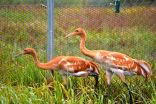When David beats Goliath
Researcher discovers chances of smaller birds winning conflicts improve when they interact with distantly related species.
2014-09-24
(Press-News.org) Body size has long been recognized to play a key role in shaping species interactions, with larger species usually winning conflicts with their smaller counterparts. But Queen's University biologist Paul Martin has found that occasionally, small species of birds can dominate larger species during aggressive interactions, particularly when they interact with distantly related species.
The new findings provide evidence that the evolution of certain traits can allow species to overcome the disadvantage of a smaller size.
"We want to understand why species live where they do, and how different species partition resources, like food, in nature," Dr. Martin explains. "This research feeds into that. The 'larger animal wins' rule that usually governs species interactions, and often influences where smaller species can live, is more likely to break down when the interacting species are distantly related."
For his research, Dr. Martin examined the outcome of 23,362 aggressive interactions among 246 bird species pairs including vultures at carcasses, hummingbirds at nectar sources and antbirds and woodcreepers at army ant swarms. The research looked at the outcome of aggressive contests for food among species as a function of their body size and evolutionary distance.
The research found that the advantages of large size declined with increased evolutionary distance between species — a pattern explained by the evolution of certain traits in smaller birds that enhanced their abilities in aggressive contests.
Specific traits that may provide advantages to small species in aggressive interactions included well-developed leg musculature and talons, enhanced flight acceleration and maneuverability and traits associated with aggression including testosterone and muscle development.
"This study examines broad patterns across many species, and now we would like to understand the details of these interactions by studying specific groups," says Dr. Martin. "We really want to understand why some species can overcome the disadvantages of small size, while other species cannot."
INFORMATION:
The research was done in collaboration with Cameron Ghalambor at Colorado State University in Fort Collins, who received a Good Family Visiting Faculty Research Fellowship to come to Queen's for the work.
The research was published in the latest issue of PLOS ONE.
ELSE PRESS RELEASES FROM THIS DATE:
First mouse model for ALS dementia
2014-09-24
CHICAGO --- The first animal model for ALS dementia, a form of ALS that also damages the brain, has been developed by Northwestern Medicine® scientists. The advance will allow researchers to directly see the brains of living mice, under anesthesia, at the microscopic level. This will allow direct monitoring of test drugs to determine if they work.
This is one of the latest research findings since the ALS Ice Bucket Challenge heightened interest in the disease and the need for expanded research and funding.
"This new model will allow rapid testing and direct monitoring ...
Findings give hope to plant extract as possible lupus treatment
2014-09-24
HOUSTON, Sept. 24, 2014 – New findings by a biomedical engineer and his team at the University of Houston (UH) raise hope for a new class of drugs to treat lupus that may not include the long list of adverse risks and side effects often associated with current treatments for this disease.
Lupus, or systemic lupus erythematosus, is a progressive, degenerative disease in which the immune system turns against itself, attacking a person's healthy tissue, cells and organs. Symptoms range from debilitating pain and fatigue to organ failure and a host of other impairments. ...
Captive whooping cranes released into the wild
2014-09-24
NECEDAH, Wis. – Four whooping crane chicks raised in captivity began their integration into the wild Saturday as part of the continuing effort to increase the wild population of this endangered species.
The cranes, hatched and raised by their parents at the U.S. Geological Survey's Patuxent Wildlife Research Center in Laurel, Maryland, were released on the U.S. Fish and Wildlife Service's Necedah National Wildlife Refuge in Wisconsin.
The chicks, about six-months old, are part of an experimental rearing and release method referred to as "parent-rearing." The parent-reared ...
NASA sees System 98W become Tropical Depression Kammuri
2014-09-24
Strong thunderstorms around the center of circulation in tropical low pressure System 98W were seen on infrared satellite imagery and were a clue to forecasters that the storm was intensifying. Early on Sept. 24, the storm intensified into Tropical Depression Kammuri far north of Guam.
NASA's Aqua satellite passed over Tropical Depression Kammuri on Sept. 24 at 12:23 a.m. EDT. Kammuri is a large storm and strong thunderstorms covered a long area within the somewhat elongated circulation. The circulation center was near the western edge of the massive extent of clouds. ...
Arabic tweets point to US influence as fuel for anti-Americanism
2014-09-24
An analysis of millions of Arabic-language tweets confirms high levels of anti-Americanism there, provides new and interesting information about attitudes in the Middle East toward particular U.S. actions, and charts a path for using Twitter to measure public sentiment in ways opinion polls cannot.
The findings also highlight policy challenges — and opportunities — for the United States in the Middle East, said Amaney Jamal, a professor of politics at Princeton University who conducted the research with colleagues at Princeton and Harvard University.
"Can the U.S. ...
Better information about prenatal testing leads to fewer tests
2014-09-24
A clinical trial led by UC San Francisco has found that when pregnant women are educated about their choices on prenatal genetic testing, the number of tests actually drops, even when the tests are offered with no out-of-pocket costs.
The findings underscore the need for clear information on all prenatal testing options and their possible outcomes, including the option of no testing, before pregnant women decide whether or not to have genetic testing, the authors said.
The study also suggests that some women may have undergone prenatal screening for Down syndrome ...
'Skin-like' device monitors cardiovascular and skin health
2014-09-24
A new wearable medical device can quickly alert a person if they are having cardiovascular trouble or if it's simply time to put on some skin moisturizer, reports a Northwestern University and University of Illinois at Urbana-Champaign study.
The small device, approximately five centimeters square, can be placed directly on the skin and worn 24/7 for around-the-clock health monitoring. The wireless technology uses thousands of tiny liquid crystals on a flexible substrate to sense heat. When the device turns color, the wearer knows something is awry.
"Our device is mechanically ...
Eyeless Mexican cavefish eliminate circadian rhythm to save energy
2014-09-24
Eyeless Mexican cavefish show no metabolic circadian rhythm in either light and dark or constant dark conditions, according to a study published September 24, 2014 in the open-access journal PLOS ONE by Damian Moran from Lund University, Sweden, and colleagues.
The Mexican tetra fish has two variants, a fully-eyed fish living close to the surface and a blind, deep water, cave-dwelling fish. Scientists in this study used these two fish to study evolutionary adaptation in fish residing in near or total darkness. The two fish types experience differences in daily light exposure, ...
Evolution of snake courtship and combat behavior
2014-09-24
A small study suggests snakes may have developed courtship and male-to-male combat behavior, such as moving undulations, neck biting, and spur-poking, over time, according to a study published September 24, 2014 in the open-access journal PLOS ONE by Phil Senter from Fayetteville State University and colleagues.
Behaviors involved in courtship and male-to-male combat have been recorded in over 70 snake species from five families in the clade Boidae and Colubroidea, but before now, scientists had yet to look for evolutionary relationships between these behaviors. The authors ...
From rats to humans: Project NEUWalk closer to clinical trials
2014-09-24
Lausanne, Switzerland. EPFL scientists have discovered how to control the limbs of a completely paralyzed rat in real time to help it walk again. Their results are published today in Science Translational Medicine.
Building on earlier work in rats, this new breakthrough is part of a more general therapy that could one day be implemented in rehabilitation programs for people with spinal cord injury, currently being developed in a European project called NEUWalk. Clinical trials could start as early as next summer using the new Gait Platform now assembled at the CHUV ...
LAST 30 PRESS RELEASES:
Science briefing: An update on GLP-1 drugs for obesity
Lower doses of immunotherapy for skin cancer give better results
Why didn’t the senior citizen cross the road? Slower crossings may help people with reduced mobility
ASH 2025: Study suggests that a virtual program focusing on diet and exercise can help reduce side effects of lymphoma treatment
A sound defense: Noisy pupae puff away potential predators
Azacitidine–venetoclax combination outperforms standard care in acute myeloid leukemia patients eligible for intensive chemotherapy
Adding epcoritamab to standard second-line therapy improves follicular lymphoma outcomes
New findings support a chemo-free approach for treating Ph+ ALL
Non-covalent btki pirtobrutinib shows promise as frontline therapy for CLL/SLL
University of Cincinnati experts present research at annual hematology event
ASH 2025: Antibody therapy eradicates traces of multiple myeloma in preliminary trial
ASH 2025: AI uncovers how DNA architecture failures trigger blood cancer
ASH 2025: New study shows that patients can safely receive stem cell transplants from mismatched, unrelated donors
Protective regimen allows successful stem cell transplant even without close genetic match between donor and recipient
Continuous and fixed-duration treatments result in similar outcomes for CLL
Measurable residual disease shows strong potential as an early indicator of survival in patients with acute myeloid leukemia
Chemotherapy and radiation are comparable as pre-transplant conditioning for patients with b-acute lymphoblastic leukemia who have no measurable residual disease
Roughly one-third of families with children being treated for leukemia struggle to pay living expenses
Quality improvement project results in increased screening and treatment for iron deficiency in pregnancy
IV iron improves survival, increases hemoglobin in hospitalized patients with iron-deficiency anemia and an acute infection
Black patients with acute myeloid leukemia are younger at diagnosis and experience poorer survival outcomes than White patients
Emergency departments fall short on delivering timely treatment for sickle cell pain
Study shows no clear evidence of harm from hydroxyurea use during pregnancy
Long-term outlook is positive for most after hematopoietic cell transplant for sickle cell disease
Study offers real-world data on commercial implementation of gene therapies for sickle cell disease and beta thalassemia
Early results suggest exa-cel gene therapy works well in children
NTIDE: Disability employment holds steady after data hiatus
Social lives of viruses affect antiviral resistance
Dose of psilocybin, dash of rabies point to treatment for depression
Helping health care providers navigate social, political, and legal barriers to patient care
[Press-News.org] When David beats GoliathResearcher discovers chances of smaller birds winning conflicts improve when they interact with distantly related species.



